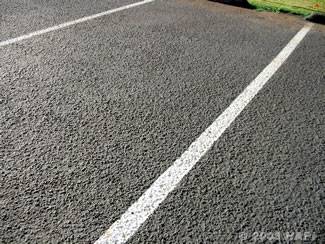Maintenance
Pavement maintenance describes all the methods and techniques used to prolong pavement life by slowing its deterioration rate. The performance of a pavement is directly tied to the timing, type and quality of the maintenance it receives.
 |
|
| Figure 1: Parking Lot Showing a Fog Seal on the Right Side | Figure 2: Slurry Seal |
Crack Seals
Crack seal products are used to fill individual pavement cracks to prevent entry of water or other non-compressible substances such as sand, dirt, rocks or weeds. Crack sealant is typically used on early stage longitudinal cracks, transverse cracks, reflection cracks and block cracks. Fatigue cracks are most often too extensive to warrant filling with crack sealer; they usually require an area treatment such as a patch or reconstruction.
| Figures 3 and 4: Crack Sealing | |
Fog Seals
A fog seal (see Figure 1) is a light application of a diluted slow-setting asphalt emulsion to the surface of an aged (oxidized) pavement surface. Fog seals are low-cost and are used to restore flexibility to an existing HMA pavement surface. They may be able to temporarily postpone the need for a BST or non-structural overlay.
| HAPI Pavement Note on Fog Seals |
Fog seals are suitable for low-volume roads or parking lots, both of which can be closed to traffic for the 4 to 6 hours it takes for the slow-setting asphalt emulsion to break and set. An excessive application rate may result in a thin asphalt layer on top of the original HMA pavement. This layer can be very smooth and cause a loss of skid resistance. Sand should be kept in reserve to blot up areas of excess application. |
Slurry Seals
A slurry seal (see Figure 2) is a mixture of emulsified asphalt, water, well-graded fine aggregate and mineral filler that has a creamy fluid-like appearance when applied. Slurry seals are used to fill existing pavement surface defects as either a preparatory treatment for other maintenance treatments or as a wearing course. Microsurfacing is an advanced form of slurry seal that uses the same basic ingredients (emulsified asphalt, water, fine aggregate and mineral filler) and combines them with advanced polymer additives.
| HAPI Pavement Note on Slurry Seals |
Slurry seals are not recommended for at least the first 6 months after a new pavement is placed. Covering a new pavement too quickly with a slurry seal may not allow the underlying pavement surface adequate time to set and harden. |
Bituminous Surface Treatments (BST)
A bituminous surface treatment, also known as a chip seal, is a thin protective wearing surface that is applied to a pavement or base course. BSTs can provide all of the following:
- A waterproof layer to protect the underlying pavement.
- Increased skid resistance.
- A fill for existing cracks or raveled surfaces.
- An anti-glare surface during wet weather and an increased reflective surface for night driving.
| HAPI Pavement Note on BSTs |
BSTs are essentially maintenance items. A BST applies an extremely thin coating of asphalt binder and aggregate that essentially carries no structural value. They are meant to provide additional protection for flexible pavements or gravel roads in relatively good condition. HMA overlays or reconstruction, and not BSTs, should be used to repair distressed roads. |
Non-Structural Overlays
Non-structural overlays do not involve extensive structural design and generally contribute little, if anything, to a pavement's structural capacity. Non-structural overlays are generally thin surface overlays of 0.5 - 1.5 inches that are used to (NAPA, 1995):
- Improve ride smoothness.
- Correct surface defects.
- Improve safety characteristics such as skid resistance and drainage.
- Enhance appearance.
- Reduce road-tire noise.
A loose classification of non-structural overlays can be done based on traffic characteristics (NAPA, 1995):
- Light volume/residential traffic. The primary objective in light traffic areas is to retard asphalt binder aging of the underlying pavement. Since heavy traffic loads are not of great concern, overlays are generally less stiff (resulting in a more workable mix, increased durability and flexibility and a potential for the overlay to reheal under traffic) and use smaller-sized aggregates.
- Heavy, high-speed traffic. The primary objective in heavy, high-speed traffic areas is to prevent rutting and provide good friction. Because of this, these overlays typically use larger angular aggregate and more durable mixes such as SMA or OGFC.
| HAPI Pavement Note on Thin Lift Paving |
Thin lift paving, such as that seen in non-structural overlays presents several construction concerns (NAPA, 1995):
|
Patches
Patches are a common method of treating an area of localized distress. Patches can be either partial or full-depth, although typically HMA pavement patches are full-depth. A high quality HMA patch can be considered a permanent repair although many patches are done as emergency repairs in poor conditions (e.g., cold, rainy) and therefore are only considered temporary repairs. Patching material can be just about any HMA or cold mix asphalt material as well as certain types of slurries. Typically some form of HMA is used for permanent patches, while cold mix is often used for temporary emergency repairs.
Pothole Patching
Pothole patching probably receives the greatest amount of public attention. Pothole patching procedures cover a wide range of methods and intentions from permanent full-depth patches to temporary on-the-fly patches. However, potholes are the result of pavement failure and therefore any patch is considered temporary until the underlying cause is determined and corrected. Two general patching procedures are described next.
 |
 |
| Figure 5: Large area patch. | Figure 6: Small permanent patch. |
Semi-Permanent Pothole Patch (see Figures 5 and 6) (from FHWA, 1998)
- Remove all water and debris from the pothole.
- Square up the pothole sides so they are vertical and have in-tact pavement on all sides.
- Place the patching material into the clean squared-up hole. The material should mound in the center and taper down to the edges so that it meets flush with the surrounding pavement edges.
- Compact the patching material starting in the center and working out toward the edges. Compaction can be accomplished using a vibratory plate compactor or a single-drum vibratory roller. Check the compacted patching material for a slight crown. This is done so that subsequent traffic loading will compact it down to the surrounding pavement height.
Throw-and-roll (from FHWA, 1998)
- Place the patching material into the pothole without any preparation or water/debris removal.
- Compact the patching material using the patching truck tires (usually 4 to 8 passes).
- Check the compacted patch for a slight crown. If a depression is present add more patching material and compact.
Although it may seem that the semi-permanent technique would produce a higher quality patch than the throw-and-roll technique, the FHWA's Long Term Pavement Performance (LTPP) Study found that the "throw-and-roll technique proved just as effective as the semi-permanent procedure for those materials for which the two procedures were compared directly" (FHWA, 1998). Since the semi-permanent technique is more labor and material intensive, the throw-and-roll technique will generally prove more cost effective if quality materials are used.


